Surface/Interfacial design and tailoring of polymeric membranes for liquid-phase separation*
Jia-qi LI, Chuan-jie FANG, Wei-lin FENG, Jin-chao FANG, Li-ping ZHU
Surface/Interfacial design and tailoring of polymeric membranes for liquid-phase separation*
Jia-qi LI, Chuan-jie FANG, Wei-lin FENG, Jin-chao FANG, Li-ping ZHU†‡
†E-mail: lpzhu@zju.edu.cn
Synthetic polymer membranes are widely used in many applications, including, among others, water purification, protein separation, and medicine. However, the use of existing polymer membranes faces major challenges, such as the trade-off between permeability and selectivity, membrane fouling, and poor mechanical strength. To address these problems the authors have focused their research on surface/interfacial tailoring and the structure-property relationship of polymer membranes used in liquid separation systems. Progress has been made as follows: (1) a methodology for membrane surface functionalization and nanofiltration (NF) membrane preparation based on mussel-inspired catecholic chemistry was proposed and established; (2) a class of mechanically robust and environmentally-responsive composite membranes with hydrogel pore-filled in rigid macroporous supports was designed and developed; (3) a methodology for surface tailoring and antifouling modification of polymer membranes based on amphiphilic copolymers was created and the scientific implications for amphiphilic polymer membranes elaborated; (4) an adsorption membrane with both filtration and adsorption functions was designed and developed to achieve rapid removal of trace micropollutants, including heavy metal ions, organic dyes, plasticizer, antibiotics, and others. This mini-review briefly summarizes this work.
Separation membranes; Amphiphilic copolymer; Catecholic chemistry; Antifouling; Adsorption membranes
1 Introduction
Synthetic polymer-based separation membranes are used in a wide variety of applications, including water treatment, protein and drug concentration, food processing, batteries and fuel cells, gas separation, air filtration, medical health, and more (Park et al., 2007; Lee et al., 2014; Mohammad et al., 2015; Tan et al., 2018). However, the existing utilization of synthetic membranes faces challenges such as the trade-off between permeability and selectivity, membrane fouling, and a complicated manufacturing process. Designing and preparing high performance (high permselectivity, antifouling, high strength, chemical stability, energy-efficiency, etc.) and multi-functional (stimuli-responsive, biocompatible, or catalytic) membranes is a significant priority in driving the development and application of membrane technology. The aim of this mini-review is to summarize our recent work on surface/interfacial design and the tailoring of traditional and novel polymer membranes used in liquid separation systems.
2 Membrane surface tailoring and functionalization based on mussel-inspired catecholic chemistry
As a versatile tool for manipulating material properties, mussel-inspired catecholic chemistry has recently become an interdisciplinary research topic of strong interest in material science, chemistry, and biomedicine. Some studies have shown that dopamine, a catecholic biological neurotransmitter widely existing in living organisms, is able to behave like mussel foot proteins in the byssal plaque of Mytilus (Fig. 1) (Zhang et al., 2017c). It undergoes oxidative self-polymerization in an alkaline aqueous solution and creates a polydopamine (PDA) coating that adheres firmly to various solid surfaces. In 2008, the authors used this strategy for the first time to perform surface chemical modification and functionalization of polymer membranes (Xi et al., 2009). Hydrophobic porous membranes were successfully hydrophilized by a simple dip-coating process with a dopamine or 3,4-dihydroxy-L-phenylalanine (L-DOPA) aqueous solution under weak alkaline conditions. The water permeability of the polymer membranes was improved by 64%. This provided a convenient method for surface modification of various polymer membranes (Xi et al., 2009).
The evolution of dopamine in the solution as well as the surface characteristics of the PDA layer on various substrates were investigated in detail, and a primary model on PDA adsorption and deposition on solid surfaces was proposed. It was found that PDA oligomers were first obtained in solution by oxidation, cyclization, and molecular rearrangements. Then, the oligomers were adsorbed, aggregated, and deposited onto substrate surfaces by non-covalent interactions (Fig. 2) (Jiang et al., 2011; Zhang et al., 2017c). This explanation concurs with that of the J.L. Lenhart group from the U.S. Army Research Laboratory (Knorr Jr et al., 2016).
Despite its advantages for membrane surface modification, PDA deposition shows some shortcomings, such as long-time consumption, high surface roughness, and weak alkaline resistance. In order to accelerate the formation of catecholic thin films instead of pure PDA, metal-phenolic network films were constructed on substrate via rapid complexation of Fe(III) ions with PDA oligomers or tannic acid. The deposition process was shortened significantly to several minutes and smoother surfaces were obtained (Lin et al., 2018; Zhang PB et al., 2019). In addition, PDA nanoparticles (NPs) were prepared by dopamine oxidation and self-polymerization. The sizes and morphologies of NPs were regulated by reaction parameters, including oxidant type, pH, reaction time, temperature, and others. The synthesized NPs were used as an additive of polymer membranes prepared by phase inversion or interfacial polymerization (Jiang et al., 2014; Zhang LL et al., 2019). It was found that both the hydrophilicity (water contact angle from 95.5° to 59.1°) and water permeability (improved by 1300%) for the membranes were greatly improved due to the incorporation of hydrophilic PDA NPs. These strategies can be extended to more polymers and catecholic substances and allow exploitation of novel functional composites.

Fig. 1 Mussel-bioinspired dopamine for material surface tailoring. Reprinted from (Zhang et al., 2017c), Copyright 2017, with permission from Journal of Functional Polymers

Fig. 2 Schematic diagram of PDA deposition on substrate surface. Reprinted from (Zhang et al., 2017c), Copyright 2017, with permission from Journal of Functional Polymers
The PDA films and aggregates containing reactive groups such as quinonyl, amine, and catecholic groups provide a versatile platform for further chemical tailoring and functionalization of membrane surfaces. A series of biopolymers or biomolecules —such as heparin, bovine serum albumin, and polymer brushes—were immobilized onto polymer membranes with an attached PDA coating or entrapped PDA NPs as the active intermediator to improve the biocompatibility or hemocompatibility of the membranes (Jiang et al., 2010, 2015; Zhu et al., 2011). In addition, polyvinyl pyrrolidone-iodine (PVP-I) was incorporated with polypropylene porous membranes by strong noncovalent interaction between PVP-I and PDA. This resulted in a significant improvement in the antifouling (permeation decay from 12.4% to 50.4%) and antibacterial (99.9% ofwere killed) properties of membrane surfaces (Jiang et al., 2013). In recent research, we reported surface fractal patterns created by the dynamic assembly of PDA nanoaggregates. Mineralization or metal deposition was used to keep the pattern fixed and maintain particular functionalities. This strategy of material surface patterning is applicable to a broad range of materials which allows the development of materials with controllable patterned structures (Zhang et al., 2017b). Moreover, the modified materials mediated by PDA have potential applications in oil/water separation, separation for lithium ion batteries, and more (Zhang PB et al., 2018, Zhang Y et al., 2018).
Hierarchically self-assembled and microporous characteristics make possible the application of PDA coating in nanofiltration. We successfully prepared a thin-film composite (TFC) membrane by depositing PDA layers on polysulfone ultrafiltration (UF) membranes. The obtained composite membranes exhibited a characteristic of positively charged NF membranes—they could completely reject the brilliant blue and Congo red dyes completely in water. This work is the first report on PDA nanofiltration (NF) membranes (Li et al., 2012). We further developed a strategy to improve the alkaline resistance of PDA NF membranes by the co-deposition of poly(ethylene imine) (PEI) and PDA followed by a crosslinking step (Zhang et al., 2017a). Moreover, the NF performances of PDA TFC membranes were further optimized by reaction conditions, such as extra amine sources, and additional crosslinked process (Tang et al., 2018; Li et al., 2019).
In summary, we performed a systematic study on the preparation and functionalization of polymer separation membranes based on mussel-inspired catecholic chemistry, and established a methodology for membrane surface functionalization and NF membrane preparation based on mussel-inspired surface chemistry. We described self-polymerization and the evolution of the typical catecholic substance, dopamine, in aqueous solutions, and we proposed a primary model on PDA adsorption and deposition on solid surfaces in solution. TFC NF membranes with PDA-based film as the selective layer were developed and used for molecular separation in liquids. Furthermore, surface functionalization of polymer membranes was performed through a secondary surface reaction with PDA as an intermediate layer. Some applications of functionalized membranes can be found in molecular filtration, protein separation, blood purification, oil/water separation, separation for lithium-ion batteries, and other fields. This mini- review offers a versatile approach for membrane surface functionalization and NF membrane preparation.
3 Design and development of amphiphilic copolymer membranes
Membrane fouling is one of the key challenges in membrane separation applications. Traditional polymer membranes are often susceptible to membrane fouling due to their hydrophobic character and low surface energy. Amphiphilic macromolecules simultaneously containing hydrophobic and hydrophilic chains in their molecular structure demonstrate great potential for integrating the advantages of hydrophobic and hydrophilic polymers in membranes. In our work to develop polymer membranes with strong antifouling properties and high mechanical strength, a series of amphiphilic copolymers with various topological architectures were designed through the blending of additives of polyvinylidene fluoride (PVDF), polysulfone (PSF), polyethersulfone (PES), and ultra-/micro-filtration membranes prepared through the phase inversion process. We investigated in detail the effects of amphiphilic macromolecules on membrane morphologies and properties. The hydrophilic chains in amphiphilic macromolecules are often immiscible with host polymers and thus are segregated onto membrane surfaces spontaneously during membrane formation. The hydrophobic part is generally miscible with the host polymer and anchored onto the membrane surface. As a result, hydrophilic and antifouling polymer brushes were immobilized onto membrane surfaces by a one-step process and the hydrophilicity and antifouling abilities of the membranes were significantly improved without sacrificing mechanical strength. Membrane flux modified by the hydrophilic polymer was improved by approximately two orders of magnitude, while antifouling ability was improved by approximately 100% (Yi et al., 2012a, 2012b, 2014b; Zhu et al., 2014a, 2014b).
Zwitterionic polymers are a class of well-known biomaterials with excellent antifouling properties due to their strong affinity with water molecules. Amphiphilic copolymers with zwitterionic chains are a strong candidate as the additive of phase inversion membranes to improve the antifouling ability of the membranes. However, a challenge for the application of zwitterionic copolymers is their low solubility in membrane-forming solvents such as,-dimethylacetamide (DMAc), and,-dimethylformamide (DMF), and thus their use in direct blending is difficult. In order to address this problem, the authors proposed a strategy based on secondary surface reaction from reactive amphiphilic copolymers blended in polymer membranes. First, nonionic amphiphilic copolymers containing tertiary amine groups were designed and synthesized. Then, the copolymers were used as the blend additive of phase inversion membranes. Finally, the surface-enriched tertiary amine groups were quaternized with 3-bromopropionic acid (3-BPA) or 1,3-propane sultone (Fig. 3). The generated zwitterionic poly(carboxybetaine methacrylate) or poly(sulfobetaine methacrylate) chains showed excellent antifouling ability for the polymer membranes (Zhao et al., 2013, 2014a, 2014b, 2015; Zhu et al., 2014a, 2014b).
Stimuli-responsivity is an attractive characteristic for polymeric membranes used in chemical separation, drug delivery, biomedical fields, and other areas. Stimuli-responsive membranes, which are composed of the membrane matrix and stimuli- responsive functional gates, can switch their permeability and separation properties in response to environmental stimuli, such as temperature, pH, ionic strength, light, electric, and magnetic fields. In the work of the authors’ group, amphiphilic copolymers containing stimuli-responsive polymer chains were designed, synthesized, and used for the preparation of stimuli-responsive membranes. It was demonstrated that the modified membranes showed stimuli- responsive characteristics in response to pH, temperature, inorganic salt, etc. The authors’ research team provided a simple and convenient strategy for the preparation of smart membranes (Yi et al., 2014a, 2015; Zhao et al., 2016).
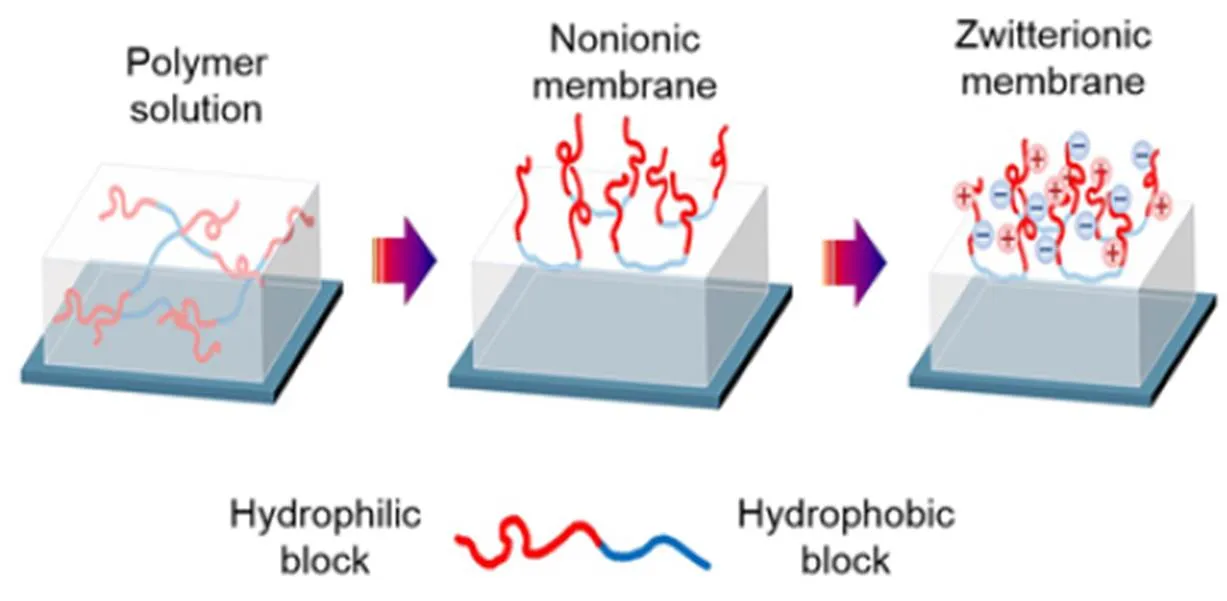
Fig. 3 Schematic diagram of membrane surface zwitterionicalization based on amphiphilic copolymer blending
The self-assembly of amphiphilic block copolymers can also be used to prepare porous polymer membranes. Free-standing symmetrical porous membranes were prepared with a polystyrene-block- poly(4-vinylpyridine) (PS-b-P4VP) diblock copolymer by combining self-assembly and nonsolvent- induced phase separation (the SNIPS process). Uniform cylindrical micelles can be constructed from the amphiphilic block copolymer during the SNIPS process. The membranes displayed an impressive ultrastructure in the overlapping of the cylindrical micelles. The water permeability of the prepared membrane reached 400 L/(m2∙h∙bar) in neutral conditions (1 bar=1×105Pa). Significantly, when the pH of the feed solution changed from 1 to 6, the permeability and selectivity of the symmetrical membrane showed a strongly pH-dependent character. The potential application of the developed membranes in the size fractionation of NPs with a wide size distribution was demonstrated (Fig. 4) (Yi et al., 2016).
Based on the above-mentioned work, a methodology for surface tailoring and antifouling modification of polymer membranes based on amphiphilic copolymers was created and the scientific implications for amphiphilic polymer membranes were discussed. The mechanisms of surface segregation of amphiphilic macromolecules during membrane formation and application were shown. The obtained membranes, modified by amphiphilic copolymers, have been frequently applied in applications such as drinking water purification, wastewater treatment, and biomedical separation.
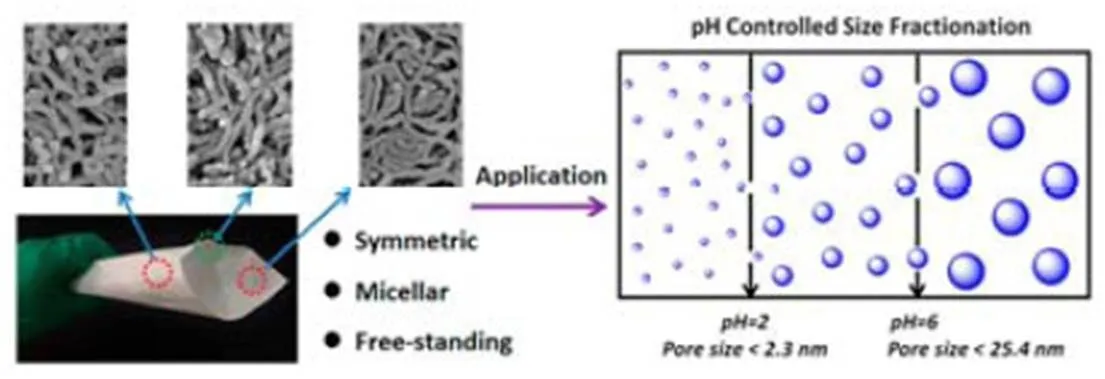
Fig. 4 pH-responsive PS-b-P4VP membranes used for nanoparticle size fractionation. Reprinted from (Yi et al., 2016). Copyright 2016, with permission from American Chemical Society
4 Design, development, and applications of gel-filled and adsorption membranes
Polymer hydrogels demonstrate strong potential in the preparation of separation membranes due to their unique mesh-like architecture and stimuli- responsive behavior. Based on a designable “hydrogel pore-filling” concept, a novel class of polymer composite membranes was developed by incorporating functional hydrogels into a porous support membrane. As a typical example, poly(-vinyl imidazole) (PVI) gel-filled composite membranes were synthesized by ultraviolet (UV)-initiated graft polymerization of a VI monomer with a crosslinking monomer from a UV-active asymmetric PSF UF support. These membranes with unique mesh-like architecture showed water permeance between ~0.5 and 10 L/(m2∙h∙bar) and pore size ranging from ~1.5 to 2 nm, depending on the PVI grafting degree. The rejections of different salts were in the order of MgCl2>NaCl»MgSO4>Na2SO4, suggesting that the rejection mechanism was dominated by Donnan exclusion (Cheng et al., 2015). In contrast to traditional NF membranes, three main mechanisms were involved in the separation: size exclusion (sieving), electrostatic repulsion (Donnan exclusion), and adsorption (involved in hydrophobic effect or electrostatic attraction). Significantly, PVI gel-filled membranes can indeed fractionate molecule mixture and molecule/salt mixture based on solute size and charge as well as on the solution condition. In particular, PVI gel-filled membranes show different pore sizes for molecular rejection in different pH conditions because of the stimuli-responsive behavior of polymer hydrogel (Cheng et al., 2016). Furthermore, a class of mechanically robust composite membranes containing polymer gels confined in the pores of rigid microporous supports has been developed and used for the rapid removal of organic pollutants such as various dyes from water through the flow-through adsorption process (Sun et al., 2016; Hu et al., 2017, 2018; Liu et al., 2017; Fang et al., 2018).
In our recent work, a crosslinked β- cyclodextrin-based polymer of intrinsic microporosity (β-CD-PIM) was designed and synthesized with the goal of removing persistent organic micropollutants—including plasticizers, pesticides, pharmaceuticals, and endocrine disrupters—from water, in an efficient and cost-effective way. The hierarchically micro-mesoporous structures and hydrophilic characteristics enable this polymer to adsorb a variety of organic pollutants from water with both at a very high rate and capacity. The maximum adsorption capacity for bisphenol A (BPA) reached 502 mg/g— approximately 5.7 times as large as that of the state- of-the-art porous β-CD polymer (Wang et al., 2019a, 2019b, 2020). A filtration membrane impregnated with a β-CD-PIM was able to remove>99.9% of BPA with a water permeability of a maximum of 1000 L/(m2∙h∙bar)—approximately 100 times greater than that of traditional NF membranes with similar functions. In addition, the membrane was easily regenerated and kept a high separation efficiency of over six adsorption-desorption cycles, exhibiting strong potential in water purification (Fig. 5) (Wang et al., 2019b).
A hydrogel in situ filling strategy was used to prepare a class of porous membranes for rapid removal of trace organic and inorganic micropollutants from water. In this technique, the hydrogel precursor was first prepared and then added into the cast solution of membranes. Subsequently, hydrogel in situ filling was conducted by further crosslinking and membrane casting. A hydrogel composite hollow fiber membrane was successfully prepared with a dry-wet spinning technique. These membranes can remove more than 99% of heavy metal ions and organic pollutants from water with a high water permeation. The separation mechanism was not attributed to size sieving or Donnan exclusion, but specifically to adsorption. The preparation of this membrane has been scaled up and a series of patents have been granted (Zhu et al., 2015a, 2015b, 2015c, 2015d). This membrane has been manufactured in large scale by the Ningbo Fotile Company, China and used in household water purifiers.
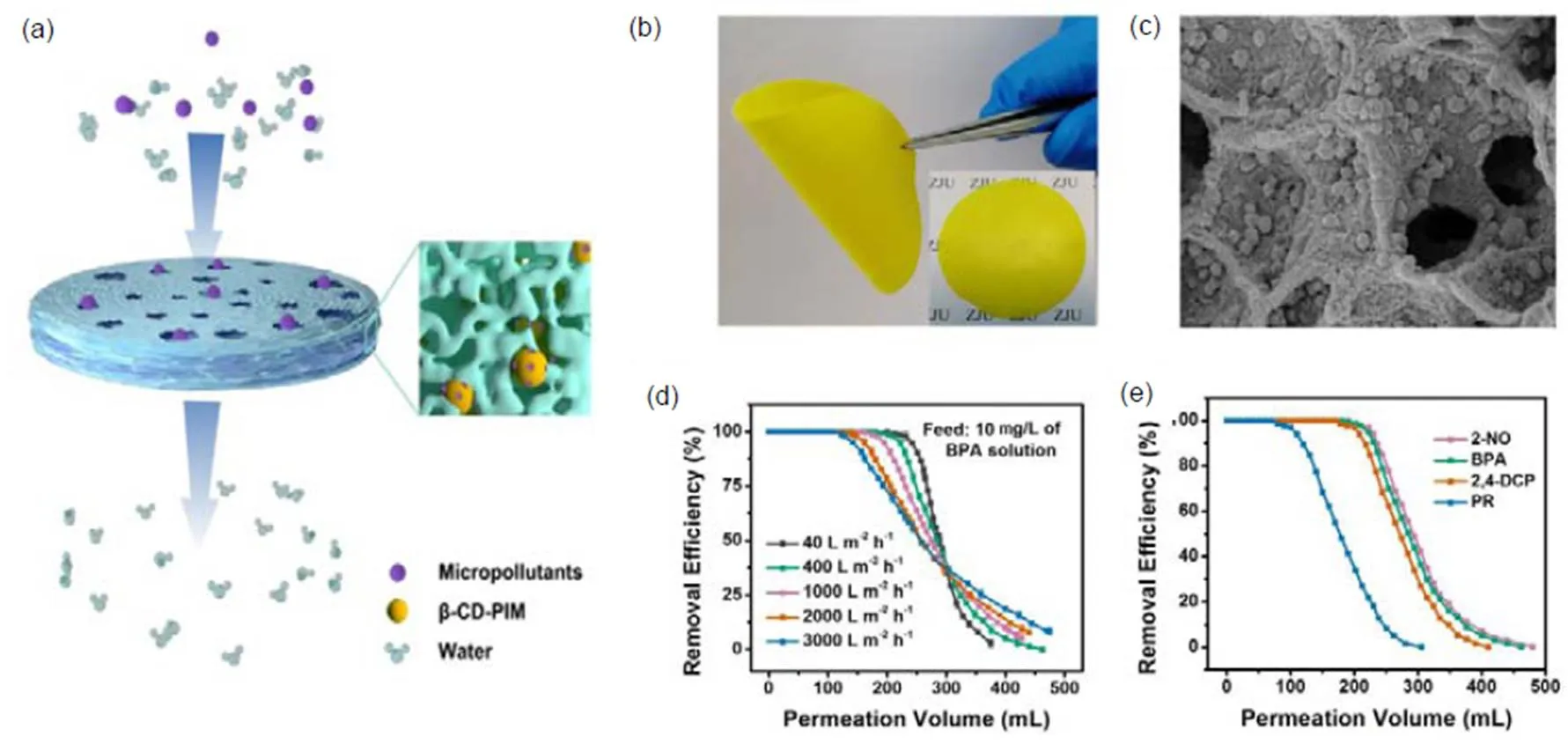
Fig. 5 PVDF/β-CD-PIM composite membrane for ultrafast removal of organic micropollutants using the flow-through adsorption process. Reprinted from (Wang et al., 2019b), Copyright 2019, with permission from Elsevier
(a) Schematic diagram of filtration and adsorption of the composite membrane; (b) Digital photograph of the composite membrane; (c) Cross-sectional SEM image of composite membrane; (d) Adsorption break-through curves of the composite membrane with various permeation fluxes; (e)Adsorption break-through curves of the composite membrane towards various single organic micropollutants
5 Summary and outlook
Membrane-based separation has been increasingly applied to address global challenges such as water scarcity, environmental pollution, industrial purification, energy storage and conversion, and health care. In our group, some advances have been made in performance improvements and multifunctionalities of traditional polymer membranes via surface/interfacial design and tailoring. The key problems, such as membrane fouling, the trade-off between permeability and selectivity, and low mechanical strength have been solved, to a certain extent. Such research is significant in its ability to propel the widespread application of membrane technologies, but much research remains to be done. To expand in new directions and remain economically viable, membrane development must seek higher performance and lower costs. In recent years, in order to break through the inherent limitations of conventional membrane materials, novel materials such as aquaporin, graphene, metal-organic frameworks, microporous organic polymers, and self-assembled block copolymers have been explored. In future research, attention should be paid to an in-depth understanding of transport and rejection mechanisms, as well as structure-property relationships. At present, these areas remain challenging. Molecular-level design and processing approaches to the fabrication of highly selective membranes should be developed. The importance to the practical application of membrane technology of the packing of membranes into optimized modules is also often neglected.
Contributors
Jia-qi LI wrote the first draft of the manuscript and revised the final version. Chuan-jie FANG revised and edited the final version. Wei-lin FENG and Jin-chao FANG processed the data curation, investigation, and visualization. Li-ping ZHU helped to organize the manuscript, and revised and edited the final version.
Conflict of interest
Jia-qi LI, Chuan-jie FANG, Wei-lin FENG, Jin-chao FANG, and Li-ping ZHU declare that they have no conflict of interest.
Cheng L, Zhang PB, Zhao YF, et al., 2015. Preparation and characterization of poly(-vinyl imidazole) gel-filled nanofiltration membranes., 492:380-391.https://doi.org/10.1016/j.memsci.2015.04.033
Cheng L, Zhu LP, Zhang PB, et al., 2016. Molecular separation by poly(-vinyl imidazole) gel-filled membranes., 497:472-484. https://doi.org/10.1016/j.memsci.2015.09.030
Fang CJ, Sun J, Zhang B, et al., 2018. Preparation of positively charged composite nanofiltration membranes by quaternization crosslinking for precise molecular and ionic separations., 531:168-180. https://doi.org/10.1016/j.jcis.2018.07.034
Hu F, Fang CJ, Wang ZH, et al., 2017. Poly(-vinyl imidazole) gel composite porous membranes for rapid separation of dyes through permeating adsorption., 188:1-10. https://doi.org/10.1016/j.seppur.2017.06.024
Hu F, Wang ZH, Zhu BK, et al., 2018. Poly(-vinyl imidazole) gel-filled membrane adsorbers for highly efficient removal of dyes from water., 1563:198-206. https://doi.org/10.1016/j.chroma.2018.05.075
Jiang JH, Zhu LP, Li XL, et al., 2010. Surface modification of PE porous membranes based on the strong adhesion of polydopamine and covalent immobilization of heparin., 364(1-2):194-202. https://doi.org/10.1016/j.memsci.2010.08.017
Jiang JH, Zhu LP, Zhu LJ, et al., 2011. Surface characteristics of a self-polymerized dopamine coating deposited on hydrophobic polymer films., 27(23):14180- 14187. https://doi.org/10.1021/la202877k
Jiang JH, Zhu LP, Zhu LJ, et al., 2013. Antifouling and antimicrobial polymer membranes based on bioinspired polydopamine and strong hydrogen-bonded poly(-vinyl pyrrolidone)., 5(24): 12895-12904. https://doi.org/10.1021/am403405c
Jiang JH, Zhu LP, Zhang HT, et al., 2014. Improved hydrodynamic permeability and antifouling properties of poly(vinylidene fluoride) membranes using polydopamine nanoparticles as additives., 457:73-81. https://doi.org/10.1016/j.memsci.2014.01.043
Jiang JH, Zhang PB, Zhu LP, et al., 2015. Improving antifouling ability and hemocompatibility of poly(vinylidene fluoride) membranes by polydopamine-mediated ATRP., 3(39):7698-7706. https://doi.org/10.1039/C5TB01336D
Knorr Jr DB, Tran NT, Gaskell KJ, et al., 2016. Synthesis and characterization of aminopropyltriethoxysilane- polydopamine coatings., 32(17):4370-4381. https://doi.org/10.1021/acs.langmuir.6b00531
Lee H, Yanilmaz M, Toprakci O, et al., 2014. A review of recent developments in membrane separators for rechargeable lithium-ion batteries., 7(12):3857-3886. https://doi.org/10.1039/C4EE01432D
Li JQ, Tang AQ, Lu JY, et al., 2019. Effects of extra amine sources on the permeability and separation properties of nanofiltration membranes prepared by polydopamine deposition., 147:10- 19.https://doi.org/10.5004/dwt.2019.23683
Li XL, Zhu LP, Jiang JH, et al., 2012. Hydrophilic nanofiltration membranes with self-polymerized and strongly- adhered polydopamine as separating layer., 30(2):152-163. https://doi.org/10.1007/s10118-012-1107-5
Lin CE, Zhou MY, Hung WS, et al., 2018. Ultrathin nanofilm with tailored pore size fabricated by metal-phenolic network for precise and rapid molecular separation., 207:435-442. https://doi.org/10.1016/j.seppur.2018.06.077
Liu CJ, Cheng L, Zhao YF, et al., 2017. Interfacially crosslinked composite porous membranes for ultrafast removal of anionic dyes from water through permeating adsorption., 337:217-225. https://doi.org/10.1016/j.jhazmat.2017.04.032
Mohammad AW, Teow YH, Ang WL, et al., 2015. Nanofiltration membranes review: recent advances and future prospects., 356:226-254. https://doi.org/10.1016/j.desal.2014.10.043
Park HB, Jung CH, Lee YM, et al., 2007. Polymers with cavities tuned for fast selective transport of small molecules and ions., 318(5848):254-258. https://doi.org/10.1126/science.1146744
Sun J, Zhu LP, Wang ZH, et al., 2016. Improved chlorine resistance of polyamide thin-film composite membranes with a terpolymer coating., 157:112-119. https://doi.org/10.1016/j.seppur.2015.11.034
Tan Z, Chen SF, Peng XS, et al., 2018. Polyamide membranes with nanoscale Turing structures for water purification., 360(6388):518-521. https://doi.org/10.1126/science.aar6308
Tang A, Lu J, Feng W, et al., 2018. Performance control of polydopamine compsite nanofiltration membranes fabricated by interfacial crosslinking., (12):1524-1531 (in Chinese). https://doi.org/10.11777/j.issn1000-3304.2018.18109
Wang ZH, Cui FC, Pan YW, et al., 2019a. Hierarchically micro-mesoporous β-cyclodextrin polymers used for ultrafast removal of micropollutants from water., 213:352-360. https://doi.org/10.1016/j.carbpol.2019.03.021
Wang ZH, Zhang B, Fang CJ, et al., 2019b. Macroporous membranes doped with micro-mesoporous β-cyclodextrin polymers for ultrafast removal of organic micropollutants from water., 222:114970. https://doi.org/10.1016/j.carbpol.2019.114970
Wang ZH, Guo S, Zhang B, et al., 2020. Interfacially crosslinked β-cyclodextrin polymer composite porous membranes for fast removal of organic micropollutants from water by flow-through adsorption., 384:121187. https://doi.org/10.1016/j.jhazmat.2019.121187
Xi ZY, Xu YY, Zhu LP, et al., 2009. A facile method of surface modification for hydrophobic polymer membranes based on the adhesive behavior of poly(DOPA) and poly(dopamine)., 327(1-2): 244-253. https://doi.org/10.1016/j.memsci.2008.11.037
Yi Z, Zhu LP, Zhao YF, et al., 2012a. An extending of candidate for the hydrophilic modification of polysulfone membranes from the compatibility consideration: the polyethersulfone-based amphiphilic copolymer as an example., 390-391:48-57. https://doi.org/10.1016/j.memsci.2011.10.058
Yi Z, Zhu LP, Cheng L, et al., 2012b. A readily modified polyethersulfone with amino-substituted groups: its amphiphilic copolymer synthesis and membrane application., 53(2):350-358. https://doi.org/10.1016/j.polymer.2011.11.053
Yi Z, Zhu LP, Zhao YF, et al., 2014a. Effects of coagulant pH and ion strength on the dehydration and self-assembly of poly(,-dimethylamino-2-ethyl methacrylate) chains in the preparation of stimuli-responsive polyethersulfone blend membranes., 463: 49-57. https://doi.org/10.1016/j.memsci.2014.03.041
Yi Z, Zhu LP, Zhang H, et al., 2014b. Ionic liquids as co-solvents for zwitterionic copolymers and the preparation of poly(vinylidene fluoride) blend membranes with dominated β-phase crystals., 55(11):2688-2696. https://doi.org/10.1016/j.polymer.2014.04.025
Yi Z, Liu CJ, Zhu LP, et al., 2015. Ion exchange and antibiofouling properties of poly(ether sulfone) membranes prepared by the surface immobilization of Brønsted acidic ionic liquids via double-click reactions., 31(29):7970-7979. https://doi.org/10.1021/acs.langmuir.5b00420
Yi Z, Zhang PB, Liu CJ, et al., 2016. Symmetrical permeable membranes consisting of overlapped block copolymer cylindrical micelles for nanoparticle size fractionation., 49(9):3343-3351. https://doi.org/10.1021/acs.macromol.6b00166
Zhang LL, Zhang MX, Lu JY, et al., 2019. Highly permeable thin-film nanocomposite membranes embedded with PDA/PEG nanocapsules as water transport channels., 586:115-121. https://doi.org/10.1016/j.memsci.2019.05.065.
Zhang PB, Liu CJ, Sun J, et al., 2017a. Fabrication of composite nanofiltration membranes by dopamine-assisted poly(ethylene imine) deposition and cross-linking., 18(2):138-150. https://doi.org/10.1631/jzus.A1600308
Zhang PB, Tang AQ, Zhu BK, et al., 2017b. Hierarchical self-assembly of dopamine into patterned structures., 4(11):1601218. https://doi.org/10.1002/admi.201601218
Zhang PB, Tang AQ, Lu JY, et al., 2017c. Separation materials based on mussel-bioinspired surface chemistry., 30(1):1-14 (in Chinese). https://doi.org/10.14133/j.cnki.1008-9357.2017.01.001
Zhang PB, Tang AQ, Wang ZH, et al., 2018. Tough poly(L-DOPA)-containing double network hydrogel beads with high capacity of dye adsorption., 36(11):1251-1261. https://doi.org/10.1007/s10118-018-2163-2
Zhang PB, Hu W, Wu M, et al., 2019. Cost-effective strategy for surface modification via complexation of disassembled polydopamine with Fe(III) ions., 35(11): 4101-4109. https://doi.org/10.1021/acs.langmuir.9b00245
Zhang Y, Yuan JJ, Song YZ, et al., 2018. Tannic acid/polyethyleneimine-decorated polypropylene separators for Li-ion batteries and the role of the interfaces between separator and electrolyte., 275:25- 31. https://doi.org/10.1016/j.electacta.2018.03.099
Zhao YF, Zhu LP, Yi Z, et al., 2013. Improving the hydrophilicity and fouling-resistance of polysulfone ultrafiltration membranes via surface zwitterionicalization mediated by polysulfone-based triblock copolymer additive., 440:40-47. https://doi.org/10.1016/j.memsci.2013.03.064
Zhao YF, Zhu LP, Jiang JH, et al., 2014a. Enhancing the antifouling and antimicrobial properties of poly(ether sulfone) membranes by surface quaternization from a reactive poly(ether sulfone) based copolymer additive., 53(36): 13952-13962. https://doi.org/10.1021/ie5019589
Zhao YF, Zhu LP, Yi Z, et al., 2014b. Zwitterionic hydrogel thin films as antifouling surface layers of polyethersulfone ultrafiltration membranes anchored via reactive copolymer additive., 470: 148-158. https://doi.org/10.1016/j.memsci.2014.07.023
Zhao YF, Zhang PB, Sun J, et al., 2015. Versatile antifouling polyethersulfone filtration membranes modified via surface grafting of zwitterionic polymers from a reactive amphiphilic copolymer additive., 448:380-388. https://doi.org/10.1016/j.jcis.2015.01.084
Zhao YF, Zhang PB, Sun J, et al., 2016. Electrolyte-responsive polyethersulfone membranes with zwitterionic polyethersulfone-based copolymers as additive., 510:306-313. https://doi.org/10.1016/j.memsci.2016.03.006
Zhu LJ, Zhu LP, Zhao YF, et al., 2014a. Anti-fouling and anti-bacterial polyethersulfone membranes quaternized from the additive of poly(2-dimethylamino ethyl methacrylate) grafted SiO2nanoparticles., 2(37):15566-15574. https://doi.org/10.1039/C4TA03199G
Zhu LJ, Zhu LP, Jiang JH, et al., 2014b. Hydrophilic and anti-fouling polyethersulfone ultrafiltration membranes with poly(2-hydroxyethyl methacrylate) grafted silica nanoparticles as additive., 451:157-168. https://doi.org/10.1016/j.memsci.2013.09.053
Zhu LP, Jiang JH, Zhu BK, et al., 2011. Immobilization of bovine serum albumin onto porous polyethylene membranes using strongly attached polydopamine as a spacer., 86(1):111-118. https://doi.org/10.1016/j.colsurfb.2011.03.027
Zhu LP, Liu CJ, Zhang PB, et al., 2015a. Preparation Method for High-strength Hydrogel Filtering Membrane. CN Patent 201510093601, China (in Chinese).
Zhu LP, Liu CJ, Fang CJ, et al., 2015b. Preparation Method for Gel Composite Separating Membrane. CN Patent 201510505066, China (in Chinese).
Zhu LP, Fang CJ, Zhao YF, et al., 2015c. Preparation Method of Composite Separating Film Filled by Interpenetrating Polymer Network Hydrogel. CN Patent 201510625391, China (in Chinese).
Zhu LP, Fang CJ, Wang ZH, et al., 2015d. Hydrogel Modified Polymer Separation Membrane Preparation Method. CN Patent 201510635859, China (in Chinese).
题目:用于液相分离的聚合物膜表/界面的设计与剪裁
概要:合成聚合物分离膜被广泛应用于水处理、蛋白质分离和医疗保健等领域。然而,传统聚合物膜面临着重大的挑战,例如渗透性和选择性之间相互制约、膜易被污染、机械强度低等。为了解决这些难题,本研究小组在聚合物分离膜的表/界面设计与剪裁以及膜材料构效关系上进行了系统的研究工作,并取得了以下进展:(1)提出并建立了一种基于贻贝仿生儿茶酚化学的膜表面功能化与纳滤膜制备新途径;(2)设计并制备了一种以刚性多孔基膜为载体的凝胶填充聚合物复合膜,发展了一种高机械强度的环境响应性分离膜制备方法;(3)建立了基于两亲聚合物的分离膜表面按需设计以及抗污改性的新方法;(4)设计并开发了一系列兼具过滤与吸附功能的吸附型分离膜,可用于水中痕量重金属离子、抗生素、塑化剂等微污染物的快速脱除。
关键词:分离膜;两亲聚合物;儿茶酚化学;抗污染;吸附膜
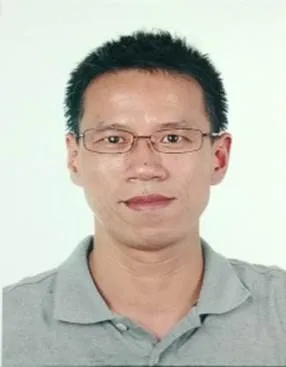
Dr. Li-ping ZHU has been the Editorial Board Member ofsince 2018. Dr. ZHU received his bachelor’s degree from Hunan University, China in 2001, and his PhD degree in polymer chemistry and physics from Zhejiang University, China in 2007. He worked on polymer chemistry and polymer membrane materials as a postdoctoral associate from 2007 to 2009 at Zhejiang University and has been employed as a faculty member from 2009 at the Department of Polymer Science and Engineering, Zhejiang University. He has been a visiting scholar at the University of California-Riverside and University of Pennsylvania, USA in 2011 and 2012–2013, respectively. Dr. ZHU has received funds for six research projects from the National Natural Science Foundation of China. To-date, he has published more than 130 peer-reviewed SCI-indexed journal papers and has been granted 24 patents. The total SCI-citation number of Dr. ZHU’s published papers is more than 4800 and his-index has reached 37. He was granted the Science & Technology Advancement Award (first prize) by the Government of Zhejiang Province in 2015 and the Science & Technology Advancement Award (first prize) by the Chemical Industry and Engineering Society of China in 2019, both in recognition of his important contributions to membrane science and technology.
https://doi.org/10.1631/jzus.A2000170
O63
*Project supported by the National Natural Science Foundation of China (Nos. 51828301, 51773175, and 51973185) and the Fundamental Research Funds for the Central Universities, China
© Zhejiang University and Springer-Verlag GmbH Germany, part of Springer Nature 2020
Apr. 16, 2020;
June 11, 2020;
July 1, 2020;
Aug. 5, 2020
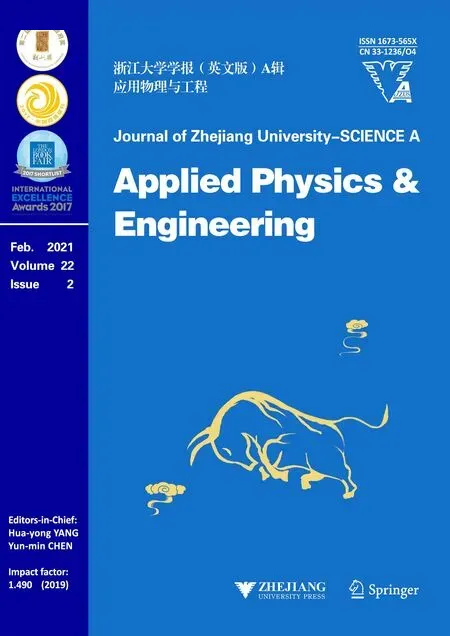 Journal of Zhejiang University-Science A(Applied Physics & Engineering)2021年2期
Journal of Zhejiang University-Science A(Applied Physics & Engineering)2021年2期
- Journal of Zhejiang University-Science A(Applied Physics & Engineering)的其它文章
- Catalytic effects of V2O5 on oxidative pyrolysis of spent cation exchange resin#*
- Modification of acidity in HZSM-5 zeolite for methane-methanol co-reaction#*
- Behavior of alkali minerals in oxyfuel co-combustion of biomass and coal at elevated pressure#*
